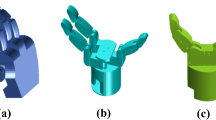Abstract
A robot grasp synthesis algorithm for automated disassembly is presented. The goal is to select grasping points in each part to be disassembled so that a previously planned disassembly sequence can be performed holding the parts firmly and avoiding collisions. The algorithm is structured in five steps in order to make it general enough to cope with different robot grippers and different geometrical data (2D or 3D). The system is learning based, and behaviour rules are automatically extracted from grasping examples given by the user, using mainly decision trees and nearest neighbour techniques. Some simulation experiments have been carried out and results with a two fingered robot gripper are presented.
Similar content being viewed by others
References
Aksoy HK, Gupta SM (2002) Capacity and buffer trade-offs in a remanufacturing system. Environ Conscious Manuf II, SPIE 4569:167–174
Gungor A, Gupta SM (2001) Disassembly sequence plan generation using a branch-and-bound algorithm. Int J Prod Res 39(3):481–509
Zeid I, Gupta SM, Bardasz T (1997) A case-based reasoning approach to planning for disassembly. J Intell Manuf 8(2):97–106
Zussman E, Zhou MC (2000) Design and implementation of an adaptive process planner for disassembly processes. IEEE Trans Robot Automat 16(2):171–179
Torres F, Puente ST, Aracil R (2003) Disassembly planning based on precedence relations among assemblies. Int J Adv Manuf Technol 21(5):317–327
Shyamsundar N, Gadh R (1999) Geometric abstractions to support disassembly analysis. IIE Trans 31:935–946
Srinivasan H, Gadh R (1998) A geometric algorithm for single selective disassembly using the wave propagation abstraction. Comput Aided Des 30(8):603–613
Torres F, Gil P, Puente ST, Pomares J, Aracil R (2004) Automatic PC disassembly for component recovery. Int J Adv Manuf Technol 23(1–2):39–46
Bicchi A (2000) Hands for dexterous manipulation and robust grasping: a difficult road towards simplicity. IEEE Trans Robot Automat 16(6):652–662
Van Holland W (1997) Assembly features in modelling and planning. Dissertation, Delft University of Technology
Puente ST (2002) Desensamblado automático no destructivo para la reutilización de componentes. Aplicación al desessamblado de PC’s. Dissertation, University of Alicante
Wai Sung RC (2001) Automatic assembly feature recognition and disassembly sequence generation. Dissertation, Heriot-Watt University
Bard C, Trocca J, Vercelli G (1991) Shape analysis and hand preshaping for grasping. Proc Intelligent Robots and Systems, Intelligence for Mechanical Systems 1:64–69
Nguyen VD (1986) The synthesis of stable force-closure grasps. Technical report AI-TR-905, MIT Artificial Intelligence Laboratory
Toth E (1999) Stable object grasping with dextrous hand in three-dimension. Periodica Polytechnica Ser El Eng 43(3):207–214
Ferrari C, Canny J (1992) Planning optimal grasps. Proc. IEEE Conf. on Robotics and Automation, Nice, pp 2290–2295
Cornellá J, Suárez R (2003) On 2D 4-finger frictionless optimal grasps. 16th IEEE/RSJ International Conference on Intelligent Robots and Systems, Las Vegas, pp 156–162
Pollard NS (1996) Synthesizing grasps from generalized prototypes. Proc IEEE International Conference on Robotics and Automation, Minneapolis, pp 901–911
Fernandez C, Vicente MA, Reinoso O, Aracil R (2004) A decision tree based approach to grasp synthesis. Proc International Conference on Intelligent Manipulation and Grasping, Genoa, pp 486–491
Hwang CS, Takano M, Sasaki K (1999) Kinematics of grasping and manipulation of a B-spline surface object by a multifingered robot hand. J Robot Syst 16(8):445–460
Hunt KH, Samuel AE, McAree PR (1991) Special configurations of multi-finger multi-freedom grippers: a kinematic study. Int J Robot Res 10(2):123–134
Jimenez P, Thomas F, Torras C (2001) 3D collision detection: a survey. Comput Graph 25(2):269–285
Lin M (1993). Efficient collision detection for animation and robotics. Dissertation, University of California
Gottschalk S, Lin M , Manocha D (1996) A hierarchical structure for rapid interference detection. Proc of ACM Siggraph’96, pp 171–180
Hudson T, Lin M, Cohen J, Gottschalk S, Manocha D (1997) V-collide: accelerated collision detection for VRML. Proc. of VRML Conference, pp 119–125
Klosowski J (1998) Efficient collision detection forinteractive 3D graphics and virtual environments. Dissertation, University of New York
Nguyen VD (1986) The synthesis of stable force-closure grasps. Technical report AI-TR-905, MIT Artificial Intelligence Laboratory
Ponce J, Faverjon B (1995) On computing three finger force-closure grasp of polygonal objects. IEEE Trans Robot Automat 11(6):868–881
Author information
Authors and Affiliations
Corresponding author
Rights and permissions
About this article
Cite this article
Fernandez, C., Reinoso, O., Vicente, M.A. et al. Part grasping for automated disassembly. Int J Adv Manuf Technol 30, 540–553 (2006). https://doi.org/10.1007/s00170-005-0054-5
Received:
Accepted:
Published:
Issue Date:
DOI: https://doi.org/10.1007/s00170-005-0054-5




